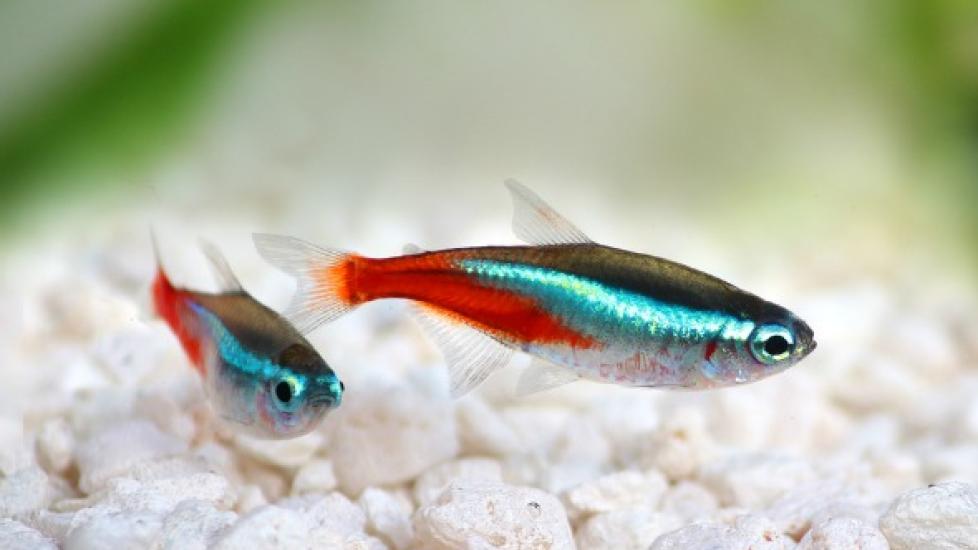5 Facts About Tetra
By Vanessa Voltolina
Be it a small glowlight tetra or a piranha, these freshwater fish have made their mark as a popular option for fish owners. With all of the shapes, sizes and colors out there, it’s understandable that pet parents may not know where to begin when including tetra in their tank.
We’ve pulled together some lesser-known facts about this popular fish, and important care tips that first-time—and even veteran—tetra owners may find helpful in making their fish feel at home:
Fact #1: There Are More Species of Tetra Than You Can Count
“Tetras are a fascinating and diverse group of fish that include things like piranha and pacu [which look similar to piranha, but can reach up to 55 pounds and tout large, human-like teeth],” said Dr. Gregory Lewbart, Professor of Aquatic, Wildlife and Zoologic Medicine at North Carolina State University, “and there are over 1100 species in the family.”
A few notable tetras include neon tetras, with a trademark silver body, neon blue stripes and a red color that stretches from the middle of their body to almost the end, and flame tetras, which don’t have blue stripes and are instead adorned with a red coloring on their backs and silver on the rest of their bodies, he confirms. Another variety, the lemon tetra, come in shades of yellow with touches of black. Tetras vary slightly in size, Lewbart confirms, with neon tetras maturing at a bit less than an inch long and flame tetras growing to about two inches.
Fact #2: They Like the Buddy System
Tetras like to live in schools (be grouped with other fish), and may get stressed if they are alone, confirmed Lewbart. “I have seen tetra tanks with literally hundreds of fish,” he said. Therefore, this species usually does well with the company of at least five to seven other tetras of the same variety (known as a shoal) in the tank. Purchasing three or more tetras from the same tank will help reduce stress and promote a healthier transition to your home tank.
Interestingly, despite their aversion to loneliness, you may not see tetra form a tight pack in a tank unless there is a threat. When it comes to choosing which fishy friends to add to the tank, “there's not a magical or uniform recipe of which fish to mix,” Lewbart said. Generally, people mix community species like Corydoras catfish or plecos with tetras. Also of importance: Avoiding carnivorous species, such as like cichlids and snakeheads.
Fact #3: How to Create Your Tetra’s Perfect Home
Neon tetras are freshwater fish that, in the wild, dwell in “acidic, dark waters of the Amazon basin,” said Lewbart. One of the first steps in making your tetra feel at home is starting with an adequate tank size. Lewbart recommends about 30 gallons for tropical fishes, which allows for more room for error if there's a disturbance in the water quality. Generally, these fish need clean water with temperatures from the mid 70s to low 80s Fahrenheit, with a cleaning regimen similar to clownfish, which is a 25 to 30 percent tank water change monthly.
Fact #4: The Life of the Party
What other fish gets their own festival? According to Lewbart, there's an annual festival that takes place in Barcelos, Brazil—a place central to the harvesting tropical fish for home aquariums—that focuses on ornamental fish. During this festival, the cardinal tetra—a bright red fish with an iridescent blue stripe that runs horizontally down its body—is one of its all-stars!
Fact #5: Tetra Love to Chow
In the wild, the neon tetras are omnivorous, consuming both meat and plants. They feed upon insect larvae, algae and other tiny invertebrates, said Lewbart. In captivity, tetras seem to do well with fresh flake food, he said, mentioning the importance of always discarding containers of flake food older than six months.
“There is often a loss of nutritional value [in flake food older than six months], and freezing keeps the food (and contained vitamins) fresher longer,” he said. “Freeze-dried blood worms and brine shrimp are also a nice treat.”
